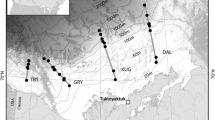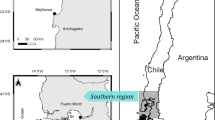Abstract
Marine birds are important predators in the marine ecosystem, and dietary studies can give useful information about their feeding ecology, food webs and oceanographic variability. The aim of this study was to increase our understanding of the diet and trophic level of the seabirds breeding in Kongsfjorden, Svalbard. We have used fatty acids and stable isotopes, both of which integrate diet information over space and time, to determine trophic relationships in marine food webs. Fatty acid compositions of muscle from Little auk (Alle alle), Brünnich’s guillemot (Uria lomvia), Black-legged kittiwake (Rissa tridactyla), Northern fulmar (Fulmarus glacialis) and Glaucous gull (Larus hyperboreus) were determined and compared with their prey species. Canonical analysis (CA) showed that fatty acid composition differed among the five seabird species. Little auk, Black-legged kittiwake and Northern fulmar had high levels of the Calanus markers 20:1n9 and 22:1, indicating that these seabirds are a part of the Calanus food chain. Brünnich’s guillemot differed from the other species with much lower levels of 20:1n9 and 22:1. Brünnich’s guillemot is a pursuit diver feeding on fish and amphipods deeper in the water column, below 30 m. Glaucous gull also differed from the other seabird species, with a larger variation in the fatty acid composition indicating a more diverse diet. Trophic level analysis placed Little auk at the lowest trophic level, Brünnich’s guillemot and Black-legged kittiwake at intermediate levels and Glaucous gull and Northern fulmar at the highest trophic level.




Similar content being viewed by others
References
Anker-Nilssen T, Bakken V, Strøm H, Golovkin AN, Biankii VV, Tatarinkova IP (2000) The status of the marine birds breading in the Barents Sea Region. The Norwegian Polar Institute Report Series, vol 113. The Norwegian Polar Institute, Tromsø
Attwood CG, Petterson WT (1989) Reduction in fecundity of lipids of the copepod Calanus australis (Brodskii) by strongly pulsed upwelling. J Exp Mar Biol Ecol 129:121–131
Barrett RT, Camphuysen K, Anker-Nilssen T, Chardine JW, Furness RW, Garthe S, Hüppop O, Leopold MF, Montevecchi WA, Veit RR (2007) Diet studies of seabirds: a review and recommendations. ICES J Mar Sci 64:1675–1691
Buchholz F, Buchholz C, Weslawski JM (2010) Ten years after: krill as indicator of change in the macro-zooplankton communities of two Arctic fjords. Polar Biol 33:101–113
Bustnes JO, Erikstad KE (1988) Diets of sympatric wintering populations of common eider Somateria mollissima and king eider S. spectabilis in northern Norway. Ornis Fenn 65:163–168
Cottier FR, MacLachlan S, Howe J (2005a) Rapid shifts in Arctic marine climate: observations and archives in a Spitsbergen fjord. Ocean Challenge 14:16–23
Cottier FR, Tverberg V, Inall M, Svendsen H, Nilsen F, Griffiths C (2005b) Watermass modification in an Arctic fjord through cross-shelf exchange: The seasonal hydrography of Kongsfjorden, Svalbard. J Geophys Res [Oceans] 110:C12005. doi:12010.11029/12004JC002757
Dahl TM, Falk-Petersen S, Gabrielsen GW, Sargent JR, Hop H, Millar R-M (2003) Lipids and stable isotopes in common eider, black-legged kittiwake and northern fulmar—a trophic study from an Arctic fjord. Mar Ecol Prog Ser 256:257–269
Dalsgaard J, St. John M, Gerard K, Müller-Navarra D, Hagen W (2003) Fatty acid trophic markers in the pelagic marine environment. Adv Mar Biol 46:227–318
Erikstad KE (1990) Winter diets of 4 seabird species in the Barents sea after a crash in the capelin stock. Polar Biol 10:619–627
Falk-Petersen S, Dahl TM, Scott CL, Sargent JR, Gulliksen B, Kwasniewski S, Hop H, Millar R-M (2002) Lipid biomarkers and trophic linkages between ctenophores and copepods in Svalbard waters. Mar Ecol Prog Ser 227:187–194
Falk-Petersen S, Haug T, Nilsen KT, Wold A, Dahl TM (2004) Lipids and trophic linkages in harp seal (Phoca groenlandica) from the eastern Barents Sea. Polar Res 23:43–50
Falk-Petersen S, Mayzaud P, Kattner G, Sargent JR (2009) Lipids and life strategy of Arctic Calanus. Mar Biol Res 5:18–39
Fisk AT, Hobson KA, Norstrom RJ (2001) Influence of chemical and biological factors on trophic transfer of persistent organic pollutants in the Northwater Polynya marine food web. Environ Sci Technol 35:735–738
Folch J, Lees M, Sloane-Stanley GH (1957) A simple method for isolation and purification of total lipids from animal tissue. J Biol Chem 226:497–509
Furness RW, Camphuysen CJ (1997) Seabirds as monitors of the marine environment. ICES J Mar Sci 59:726–737
Gabrielsen GW (2009) Seabirds in the Barents Sea. In: Sakshaug E, Johnsen G, Kovacs K (eds) Ecosystem Barents Sea. Tapir Academic Press, Trondheim
Gjertz I, Mehlum F, Gabrielsen GW (1985) Food sample analysis of seabirds collected during the “Lance-cruise” in ice-filled waters in Eastern Svalbard 1984. Norwegian Polar Institute Report Series, vol 23. Norwegian Polar Institute, Oslo
Hobson KA, Clark RG (1992) Assessing avian diets using stable isotopes II. Factors influencing diet-tissue fractionation. Condor 94:189–197
Hobson KA, Welch HE (1992a) Determination of trophic relationships within a high-arctic marine food web using δ13C and δ15N analysis. Mar Ecol Prog Ser 84:9–18
Hobson KA, Welch HE (1992b) Observations of foraging Northern Fulmars (Fulmarus glacialis) in the Canadian High Arctic. Arctic 45:150–153
Hobson KA, Ambrose WG Jr, Renaud PE (1995) Sources of primary production, benthic-pelagic coupling, and trophic relationships within the Northeast Water Polynya: insights from δ13C and δ15N analysis. Mar Ecol Prog Ser 128:1–10
Hobson KA, Fisk A, Karnovsky N, Holst M, Gagnon J-M, Fortier M (2002) A stable isotope (δ13C, δ15N) model for the North Water food web: Implications for evaluating trophodynamics and the flow of energy and contaminants. Deep-Sea Res Part II 49:5131–5150
Hop H, Borgå K, Gabrielsen GW, Kleivane L, Skaare JU (2002a) Food web magnification of persistent organic pollutants in poikilotherms and homeotherms from the Barents Sea. Environ Sci Technol 36:2589–2597
Hop H, Pearson T, Hegseth EN, Kovacs KM, Wiencke C, Kwasniewski S, Eiane K, Mehlum F, Gulliksen B, Wlodarska-Kowalczuk M, Lydersen C, Weslawski JM, Cochrane S, Gabrielsen GW, Leakey RJG, Lønne OJ, Zajaczkowski M, Falk-Petersen S, Kendall M, Wängberg S-Å, Bischof K, Voronkov AY, Kovaltchouk NA, Wiktor J, Poltermann M, di Prisco G, Papucci C, Gerland S (2002b) The marine ecosystem of Kongsfjorden, Svalbard. Polar Res 21:167–208
Hop H, Falk-Petersen S, Svendsen H, Kwasniewski S, Pavlov V, Pavlova O, Søreide JE (2006) Physical and biological characteristics of the pelagic system across Fram Strait to Kongsfjorden. Prog Oceanogr 71:182–231
Iverson SJ, Field C, Bowen WD, Blanchard W (2004) Quantitative fatty acid signature analysis: a new method of estimating predator diets. Ecol Monogr 74:211–235
Iverson SJ, Springer AM, Kitaysky AS (2007) Seabirds as indicators of food web structure and ecosystem variability: qualitative and quantitative diet analyses using fatty acids. Mar Ecol Prog Ser 352:235–244
Jæger I, Hop H, Gabrielsen GW (2009) Biomagnification of mercury in selected species from an Arctic marine food web in Svalbard. Sci Total Environ 407:4744–4751
Käkelä A, Furness RW, Kelly A, Strandberg U, Waldron S, Käkelä R (2007) Fatty acid signatures and stable isotopes as dietary indicators in North Sea seabirds. Mar Ecol Prog Ser 342:291–301
Karnovsky NJ, Kwasniewski S, Weslawski JM, Walkusz W, Beszczynska-Möller A (2003) Foraging behavior of little auks in a heterogeneous environment. Mar Ecol Prog Ser 253:289–303
Karnovsky NJ, Hobson KA, Iverson S, Hunt Jr GL (2008) Seasonal changes in diets of seabirds in the North Water Polynia: a multiple indicator approach. Mar Ecol Prog Ser 357:291–299
Kwasniewski S, Hop H, Falk-Petersen S, Pedersen G (2003) Distribution of Calanus species in Kongsfjorden, a glacial fjord in Svalbard. J Plankton Res 25:1–20
Lydersen C, Gjertz I, Weslawski JM (1989) Stomach content of autumn feeding marine vertebrates from Hornsund, Svalbard. Polar Rec 25:107–114
Mallory ML, Karnovsky NJ, Gaston AJ, Hobson KA, Provencher JF, Forbes MR, Hunt GL Jr, Byers T, Dick TA (2010) Temporal and spatial patterns in the diet of northern fulmars Fulmarus glacialis in the Canadian Arctic. Aqua Biol 10:181–191
Mehlum F, Bakken H (1994) Seabirds in Svalbard (Norway): status, recent changes and management. Seabirds on islands threats, case studies and action plans. Birdlife conservation series. BirdLife International, Cambridge
Mehlum F, Gabrielsen GW (1993) The diet of high-arctic seabirds in coastal and ice-covered, pelagic areas near the Svalbard archipelago. Polar Res 12:1–20
Mizutani H, Kabaya Y, Wada E (1991) Nitrogen and carbon isotope compositions relate linearly in cormorant tissues and its diet. Isotopenpraxis 4:166–168
Niizuma Y, Gabrielsen GW, Katsufumi S, Watanuki Y, Naito Y (2007) Brünnich’s guillemots (Uria lomvia) maintain high temperature in the body core during dives. Comp Biochem Physiol B-Biochem Mol Biol 147:438–444
Peterson BJ (1999) Stable isotopes as tracers of organic matter input and transfer in benthic food webs: a review. Acta Oceol-Int J Ecol 20:479–487
Quillfeldt P, Bugoni L, McGill RAR, Masello JF, Furness RW (2008) Differences in stable isotopes in blood and feathers of seabirds are consistent across species, age and latitude: implications for food web studies. Mar Biol 155:593–598
Søreide JE, Hop H, Carroll ML, Falk-Petersen S, Hegseth EN (2006) Seasonal food web structures and sympagic-pelagic coupling in the European Arctic revealed by stable isotopes and a two-source food web model. Prog Oceanogr 71:59–87
Steen H, Vogedes D, Broms F, Falk-Petersen S, Berge J (2007) Little auks (Alle alle) breeding in a High Arctic fjord system: bimodal foraging strategies as a response to poor food quality? Polar Res 26:118–125
Svendsen H, Beszczynska-Möller A, Hagen JO, Lefauconnier B, Tverberg V, Gerland S, Ørbæk JB, Bischof K, Papucci C, Zajaczkowski M, Azzolini R, Bruland O, Wiencke C, Winther J-G, Dallmann W (2002) The physical environment of Kongsfjorden-Krossfjorden, an Arctic fjord system in Svalbard. Polar Res 21:133–166
Tamelander T, Renaud PE, Hop H, Carroll ML, Ambrose WG Jr, Hobson KA (2006) Trophic relationships and pelagic-benthic coupling during summer in the Barents Sea Marginal Ice Zone, revealed by stable carbon and nitrogen isotope measurements. Mar Ecol Prog Ser 310:33–46
ter Braak CJF, Šmilauer P (2002) CANOCO Reference manual and CanoDraw for windows User’s guide: software for canonical community ordination (version 4.5). Microcomputer Power, Ithaca, New York
Wang SW, Iverson SJ, Springer AM, Hatch SA (2009) Spatial and temporal diet segregation in northern fulmars Fulmarus glacialis breeding in Alaska: insights from fatty acid signatures. Mar Ecol Prog Ser 377:299–307
Welcker J, Harding AMA, Karnovsky N, Steen H, Strøm H, Gabrielsen GW (2009) Flexibility in the biomodal foraging strategy of a high Arctic alcid, the little auk Alle alle. J Avian Biol 40:388–399
Willis K, Cottier F, Kwasniewski S, Wold A, Falk-Petersen S (2006) The influence of advection on zooplankton community composition in an Arctic fjord (Kongsfjorden, Svalbard). J Mar Syst 61:39–54
Acknowledgments
We wish to thank Sverdrup Station, Norwegian Polar Institute for logistic assistance during field work. IFE and UNILAB Analyse are acknowledged for performing respectively the stable isotope and fatty acid analyses.
Author information
Authors and Affiliations
Corresponding author
Rights and permissions
About this article
Cite this article
Wold, A., Jæger, I., Hop, H. et al. Arctic seabird food chains explored by fatty acid composition and stable isotopes in Kongsfjorden, Svalbard. Polar Biol 34, 1147–1155 (2011). https://doi.org/10.1007/s00300-011-0975-4
Received:
Revised:
Accepted:
Published:
Issue Date:
DOI: https://doi.org/10.1007/s00300-011-0975-4




